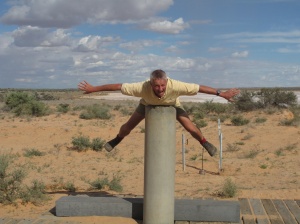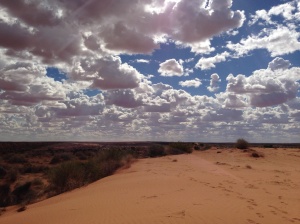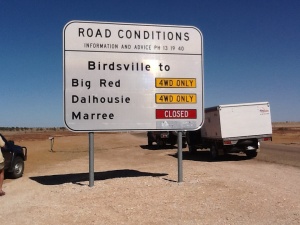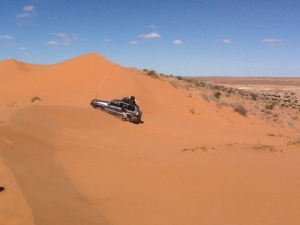Category Archives: Desert
Campsite on the Tanami Road

Flying north
I fly in to Alice. A short drive from the airport and we’re on the Tanami Road, heading into the remote desert north of Alice Springs. Suddenly I’m in another world. Am I ready? My mind is still in Pennyroyal with our farm, the cows, dogs, chooks, geese. Even the wellbeing of the bees in our hives gets a fleeting thought.
We camp the night at Tilmouth Well. It’s winter in the red centre and oh, so cold. Mint and rosemary lamb chops sizzle on the campfire grill. The hot meal and layer upon layer of clothing are our attempt to ward off the cold.
It’s Territory Day. The only day of the year it’s legal to set off fireworks without a permit. What a shame we don’t have any. After dinner we leave the warmth of the fire to explore a dry sandy creek bed running alongside the campsite. A secretive Howard runs ahead, on a mission. What is he up to? The dark night explodes with a spinning sputtering wheel of light and we cheer! Fireworks! Vive le Territory!
Our cosy camper feels more like an icebox when we retire to bed. I’m under the doona fully clothed, wearing the hood up on my fleecy hoodie against the chill. But sleep comes quickly and soon the icy cold night breaks into a clear bright day. Lying in bed I pull out Songlines by Bruce Chatwin, my choice of reading for this trip. In the first chapter I read how aboriginal myths describe the creation of the world. They believe their dreamtime ancestors walked through the country singing the land and all that lived in it into being. I love this idea. Life from song.
Humming Nessun Dorma I quietly sing this day into life. I climb out of the camper and line up my wash bag contents on the rickety little camp table. The sun shines through the gum trees. Its weak rays carry the promise of warmer weather. I splash icy water onto my face and shock my system awake to start the day. Time to head north.

Red Sands and Salt Lakes
Here’s a missing post that was written on our second day in the Simpson Desert. It didn’t make it up on to the blog, so it’s a bonus for you today.
********
Refreshed from a night of deep sleep in the warm, dry desert air, we breakfast quickly and make an early start on the road again.
Once again we are making our way over and across the parallel waves of sand. The dunes rise and fall in front of us, creating a rhythm of their own. The rhythm is hypnotic, up and down, up and down. We become part of the song of the desert as we climb to the crest of each dune and then drop away to the trough. The note of the engine rises and falls as gears change. The drivers are focused, selecting the right gear, choosing the best track to make their way over the dunes. They cannot help but move to the beat of the desert’s song.
It is a beautiful song. Red sienna dunes rise from grey sandy troughs. Clawed tree branches clutch at the pastel blue sky. The colours change in time with the rhythm created by the shape of the land. Up and down, up and down. As we drive deeper into the desert, the colours grow more intense. The channels between the dunes are dotted with squat bonsai-like trees, yellow flowers in silvery grey foliage. The desert is beautiful but hers is a harsh environment. To survive here, plants must live in an arid sandy soil under the fierce glare of the sun. They defend themselves from dehydyration by growing a silvery armour on their leaves and holding on tightly to any water that falls, storing it within. Life in the desert is always on her terms.
We cross paths with a group of fellow travellers in Land Rovers. They have decided to ignore some of the desert park rules and are not pleased to be reminded of them. Live and let live, but safety must come first in the desert. You can lose your life here, or cause others to lose theirs.
As the the sun rises into the sky, the colours around us deepen. The sand blushes in pastel red and orange hues, complimented by the milky blue sky. And still the rhythm of the dunes beats on, up and down, up and down.
We lunch quickly, keen to make progress on our journey, impatient to rejoin the hypnotic rhythm. We drive on. In the early afternoon we come to the first of many salt lakes, empty estuaries that are part of the great inland water system that runs into Lake Eyre. Lake Eyre is fed by a network of channels and waterways that stretches all the way to the East coast of Australia and far to the North and South. It may be the last truly unregulated lake catchment system in the world. Water flows as nature intended, as it has for millions of years. For now, the salt lakes are dry and wait patiently for water to come. Salt has crystallised on the exposed surface of the lakes, forming a crisp white crust that is strangely reminiscent of an early fall of snow in colder climates.
The lakes break the rhythm of the dunes. They are flat and even. We drive across them with ease. The pure white of the salt contrasts with the red sand and sparkles in the bright sun light. Here and there the pristine salt surface of the lakes has been disturbed by the tyre tracks of errant drivers. Man leaves his mark.
The coloured sand flags on our vehicles wave to and fro as we drive around Lake Poeppel to Poeppel’s Corner where three state lines meet. We find the marker post and prove that it is possible to have your photo taken with one arm in Queensland, one arm in the Northern Territory and your legs in South Australia. This is most impressive when it is achieved by lying stomach down on the marker pole, legs and arms stretched out like a starfish. Those who attempted this will take home an unexpected souvenir, an imprint of three state names on the sensitive skin of their stomachs. But it had to be done!
At Poeppel corner we leave the QAA Line for the French Line. “Ooh la la!” Time for a little French over the radio. We are soon put in our place by the support truck for a group of motorbikers crossing the Simpson from West to East. “You’re not the only ones using this channel you know.” “Quelle dommage…”
As the afternoon draws on, the sky fills with hundreds of flat bottomed clouds, brilliant white on top and a dusky pink grey below. Is it going to rain? We rejoin the rhythm of the dunes, up and down, up and down, rock and roll, rock and roll. Red sands blush more deeply and clumps of bright yellow flowers add another colour to the desert mix.
It is time to call it a day and we pull in to a perfect camp spot. The fire is soon alight and we end the day with a camp oven roast, much laughter and Malcolm’s memorable impersonation of Elvis Presley. The evening is cut short by a shower of unexpected desert rain. We take to the shelter of our tents and lie in bed listening to the sound of raindrops as the subliminal background rhythm of the desert beats on.

Bush Poetry #3
By Christine Smith
The softness of a dressing gown
Dyed in the hues of the desert
Suzanne, yes I did notice
Your nurturing hands releasing
Our survival kits to adventure
“Bon Voyage would-be Diggers”.
The Prison of Warwick weeps
Across lushness, green
Who invented the bars of exclusion?
Autumn leaves scatter with tourists roaming
That extra H of Hahndorf
Echoes the bells of Europe
The gulping of beer,
The ode to holidays
Tempts the thirst
Across hills of vineyards
As the Pen folds onto the
Chalice of Cab Sav and twisted sheets
Lutheran dreams and Hans Heysen landscapes
Where knarled Herbnick eyes gaze hollowed,
as the Cornish leave rugged cliffs for
Their burrows to copper as we
Would be Diggers are lulled by giant wind gods
While McCartney unplugged harmonises
With Ulolooloo, Orroroo and Wallaway hey hey,
Cupp’d or cocktails? Hey hey hey!
Yes, I am serious
The hub of the Flinders
Is not the Hawker of barking dogs and whinging toms
But Jeff Morgan’s palette of
Sharpened ridges and smokey grey ranges
Compared with undies drying on the dash
Framing a landscape
Is this the moon?
Roads forget their fences as
I breathe in wilderness
Brachina gorge collects 520 million
Years of existence as trees
Line the hills like Sydney bridge climbers
No wilderness
Back on track
The land flattens like a
Giant pancake to laughing skies
Red gibbers shine their tongues to
The ancestors of rivers and wind
Farina beckons an ancient oven
Of cream buns and
Hollowed corridors embrace ceilings of stars
A heart broken mother in the loss of your son
Beloved sons and daughters
This is the wilderness
The breath of the Outback.
Christine Smith
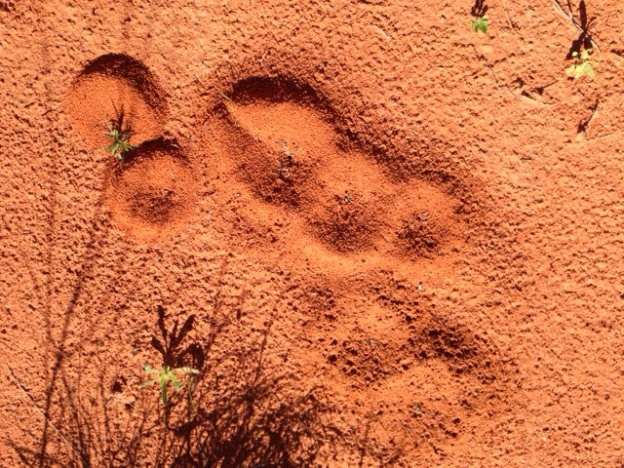
Simpson desert dreaming
One week on the road. Our normal lives feel so distant, it is hard to imagine being anywhere but here.
The desert grows more beautiful day by day. The rippling sand dunes are now covered with lush green vegetation. Recent rains have brought the desert to life. Two jet black eagles sit regally on a dune, watching us pass by. Their dark forms silhouetted against the red sand. Smaller birds twitter as they fly through the desert’s wild flower meadows. Flowers, grasses and small acacias populate the dunes, artfully planted it appears, as if to win a native garden show.
The bleached tops of cane grass tufts sprout like whiskers on the banks of the dunes. Purple flowers blend with clumps of native spinifex. A solitary kangaroo hops slowly away then turns to watch us from his garden home. There is plenty here for us all, he seems to say.
This truly is a botanist’s paradise. I lose count of the different species of flowers, shrubs and trees that we pass by. Bright yellow flowers dominate entire dune banks. From the viewing point on top of the higher dunes we see the desert garden stretching far into the distance on all points of the compass. Grey, green, yellow stripes on powder red sand.
Look, a dingo, clearly visible with her blonde fur against the colours of the desert. She looks at us, tongue lolling from her mouth, then walks away. There is plenty here for us all, she seems to say. Food is abundant for plant, animal and bird life after the rains.
As we drive towards Purni Bore, where we will eat lunch, we notice the land flattening. We are not yet out of the desert, but we are leaving her heart behind. We enjoy the luxury of a new shower and toilet block at Purni Bore and then drive on the flat pan, away from the dunes.
The soft sand is but a memory as we travel on rock strewn roads through the flattest country. In the distance we can see the flat topped mountains of the Emery Range. Our tyres are soft. The pressure was reduced to drive better on sand. We now begin to grow concerned that the rocks may cause a puncture. As it happens, the only casualty is our sand flag, that flies away, heading back to the desert’s heart. We understand the desire to return.
We drive forward on the rocky roads to Dalhousie Springs. The hot springs here are naturally created by water being forced up from the Great Artesian Basin that lies below us. This water is heated by high temperatures in the earth’s core and emerges at the surface at a comfortable 36-38 degrees. Time for a hot bath! We jump in and wash off the desert dust.
Out of Dalhousie Springs the roads are corrugated and rocky. It’s is not a comfortable ride. We stop off for a brief respite at Opossum watering hole. A sign reminds us that this is a significant place for aboriginal people. The magical stories of the Dreaming converge on watering holes such as this that have been used for thousands of years. It is easy to understand why.
Back on the rocky road, shaken but not stirred, we drive the last stretch of the day to Mount Dare. The red clay roads are deeply rutted. A final driving challenge before we camp and enjoy the hospitality of the Mount Dare Hotel.

Bush Poetry #2
Legs of the desert
by Max Smith
Over the rolling sand dunes
In a land that’s deemed so harsh
With a band of intrepid travellers
That all came from Deans Marsh
Through grit and determination
And working as a team
The achievement of these people
Was something to be seen
From dodging rutting camels
And eating such hard cakes
The lifting of ones spirits
Is what this land doth make
While sitting round the camp fire
When all of us are at rest
The joy of meeting new faces
And being put to a test
Will always be a memory
Until I’m laid to rest.
May 2014

Simpson Desert Day
Today is our second day driving through the Simpson desert.
I can share with you, dear reader, that it is unusually beautiful here. The colour of the sand, which varies from a creamy tan to a dusky pink, is a constant contrasting backdrop to the greys, greens and yellows of the vegetation. Wildflowers are unexpectedly prolific. We are lucky to see the desert in bloom. Flowers of yellow, white and mauve compete for attention with wattles decorated with yellow pompom flowers, with the complex geometric shapes of clumps of sand hill cane grass and spiky tufts of spinifex. I take hundreds of photos. I want to capture the memory of these sights and savour it forever.
We are not alone here. The desert is alive, but we see few of its inhabitants. The sand is traced with a multitude of prints, giving away their secret nocturnal existence. Dingo tracks follow the road for many kilometres. Tiny birds fly from bush to bush. Emus are spotted walking across the sands. A lizard slithers by. The ecosystem is alive and well, thriving on recent rains.
Our vehicles are tested by the harsh conditions and relentless low gear four wheel driving. They rock and roll as they climb the dunes. They shake and rattle as they twist and turn and any loose items are thrown about inside. A milk container is cracked, glass and plastic broken. Batteries fail and fuses blow. Fridge contents are thrown around as if in a blender. But the utes drive on, revelling in an opportunity to exercise their full capabilities. Few road cars ever have this work out.
We travel slowly at approximately 20 km/hr, looking out for other vehicles coming towards us on the track. Through the day we meet seven vehicles driving from West to East, the opposite direction to us. Nearing the end of the day, a large sand dune stops Howard in his tracks. As he is reversing down, an oncoming vehicle appears on the crest above him. A close call.
This last dune is going to be a difficult one to climb. It is deceptive. Approaching what appears to be the top, a second hidden summit emerges. It is two dunes in one. The sand at the top is soft. One by one the vehicles attempt the climb. First hard right, then hard left. After a few false starts everyone but Max is over. The V8 roars and here he comes, up to the right, then to the left. A glimpse in through the windscreen and we can see Max relaxed, a cigarette in his mouth, totally at ease as he twists the wheel and the Landcruiser ploughs through the sand to reach the summit. A cool customer.
The shadows are long in the late afternoon sun and we stand on top the dune for a while to take in the view. The desert stretches out below us. A spectacular end to another perfect day.

Bush Poetry #1
Poetry around the camp fire
I’m in the desert
The Simpson Desert
We’ve travelled many miles
I’m sitting in the sand
Red sand
Big red is in the distance
It seems it must be conquered
And conquer it we did
Clumps of grass and acacia dot the dunes
Flies annoy my eyes
The sky is blue and goes on forever
Horizon too seems far away
I gather up my sticks and play.
by Beryl Bush

Birdsville to the Simpson
The sound of dingoes wailing like banshees breaks the silence of the desert night. We are in Birdsville. Today we venture into the desert.
Sand flags are attached to our vehicles and straps are checked and tightened to make sure everything is ready for the desert crossing. We take a trip to the tourist information office to buy our desert parks pass and we are ready to go. A refuel at the servo and a detour past the bakery for a coffee and cake is all we need to set us up for the journey.
Birdsville has lived up to its reputation. A friendly place with every facility a traveller could need. It may be a remote destination, but it has the feel of a real town with a strong community.
A few kilometres outside the town, we stop for the obligatory photo beside the road sign to Big Red, the famous sand dune. Big Red is the highest dune in the Simpson desert, standing at around 50 metres. It lays down a challenge to our drivers that they are keen to accept.
As we prepare to leave the photo spot Brett and Christine find their ute will not start. A dead battery is the cause. We thank the desert gods that the battery has failed so close to town, where it is easy to buy a replacement. Out in the desert this would have been a more challenging problem to solve. Back to Birdsville we go. It does not take long. Battery purchased, fitted and tested and we are off.
The Simpson Desert is the world’s largest parallel dune desert. It is made up of over a thousand parallel dunes running along its length from NE to SW. Our route will run from E to W, along the QAA line to Poeppel Corner and then along the French Line to Mount Dare Hotel. We will be moving across and over the dunes and will have some challenging 4WD action ahead of us.
The first sand dune is relatively easy to climb, but we novices feel a surge of excitement when we successfully reach the other side. Next comes Big Red. It is slightly off the main track, and is not on our route, but it is definitely on our itinerary. We take the side track towards it, see the dune ahead and the adrenalin starts to run in anticipation. Howard is first to attempt the giant dune. He easily reaches the summit on the second attempt. We see two figures at the top, watching the rest of the team’s attempts. Max hurtles towards the dune and loses power about three quarters of the way up. He reverses back down and powers back for his second attempt. He does it. He and Heather stand at the top looking down.
Malcolm and Olive try twice unsuccessfully to climb the dune, but they have conquered it before and decide to sit this one out. Brett steps up to the plate and powers up the sandy incline. The ute loses power in the middle of the dune. He tries again and gets almost to the top, but can’t find the traction to get through the soft sand at the summit. He decides to call it quits. It’s been a tough day already and he will pass on this challenge.
Richard lines up to take his turn. He charges at the dune, wrestling with the wheel to stay on track, only to lose traction midway. Four more attempts in different gears see him climb to the very top of the dune, only to lack enough power for the final push over the crest. Another group of vehicles approaches the dune and he knows he only has time for one more try. He is determined to conquer the colossus and his face is set as he lines up for his attempt. The radio crackles with advice on the gear to select, “Low 2”, “High 3”. He selects low 3 and manoeuvres the ISUZU to the starting point. At the last minute he flicks off the air conditioning, hoping that might help him find the extra few horse power he is looking for.
Off he goes, power on, up to middle of the dune, the vehicle gains traction as he turns to the left and the ISUZU pushes forward, finally easing over the crest and on to the summit. A shout of exhilaration and he’s out of the vehicle, punching the air. Mission accomplished.
With the excitement of Big Red behind us, we continue our drive into the desert. Every dune presents a different driving challenge. The convoy soon gets into the groove and we make slow but sure progress through the afternoon.
Beryl calls out over the radio, “We’re in paradise!” We climb the dune to find a treed plain below us that reminds me of an olive grove. The flat plain between two distant dunes is dotted with silvery grey green trees. We have found our first desert camp site. Wood is collected, a fire is set and we make camp.
After a tasty dinner, we sit around the camp fire, looking up at the starry starry night. Earlier in the day, Beryl had laid down a challenge to the group to each write a poem to read around the campfire. What a talented group! The poems each reflected the personality of the author – some comical, others lyrical – all giving a new perspective on the trip so far.
I will share a selection of these poems in future posts under the category “Bush Poetry” so that you, dear reader, can hear other voices tell the story of our travels into the red centre of Australia to see the Big Red Bit.






